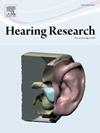Effects of polychlorinated biphenyls on the peripheral and central auditory systems
IF 2.5
2区 医学
Q1 AUDIOLOGY & SPEECH-LANGUAGE PATHOLOGY
引用次数: 0
Abstract
Polychlorinated biphenyls (PCBs), a class of persistent endocrine-disrupting chemicals, continue to pose significant risks to human and environmental health due to their widespread distribution, lipophilicity, and ability to bioaccumulate. Of particular concern is exposure during critical periods of neurodevelopment, which has been associated with long-lasting effects on sensory systems, including auditory processing. This review elaborates findings from both human epidemiological studies and animal models to examine the effects of PCBs on auditory function across the peripheral and central auditory pathways. Evidence indicates that PCB exposure during gestation and early postnatal life can lead to permanent auditory deficits. At the level of the auditory periphery, reductions in distortion-product otoacoustic emissions (DPOAEs) and auditory brainstem responses (ABRs) suggest cochlear outer hair cell dysfunction, potentially mediated by oxidative stress. Centrally, alterations in the primary auditory cortex and inferior colliculus have been observed, including disrupted tonotopic organization, excitation–inhibition imbalance, and impaired neuroplasticity. Notably, such central neural changes can occur out of proportion to abnormalities in ABRs, pointing to central auditory vulnerabilities. Epidemiological data in humans further support these findings, with certain PCB congeners linked to a significantly elevated risk of hearing impairment in children. PCB exposure coupled with loud noise exposure, which is growing in prevalence, leads to cumulative deficits in auditory processing. Together, these findings highlight the multi-level impact of PCB exposure on the auditory system and highlight the need for further investigation into the molecular and circuit-level mechanisms underlying these effects. Understanding the actions of PCB congeners on the auditory system in various human population cohorts is important to inform risk assessment and guide future public health policies.
多氯联苯对外周和中枢听觉系统的影响。
多氯联苯(PCBs)是一类持久性内分泌干扰化学物质,由于其广泛分布、亲脂性和生物积累能力,继续对人类和环境健康构成重大风险。特别值得关注的是,在神经发育的关键时期暴露在这种物质中,会对包括听觉处理在内的感觉系统产生长期影响。这篇综述阐述了人类流行病学研究和动物模型的发现,以检查多氯联苯对周围和中枢听觉通路听觉功能的影响。有证据表明,在妊娠期和产后早期接触多氯联苯可导致永久性听觉缺陷。在听觉外周水平,畸变产物耳声发射(dpoae)和听觉脑干反应(ABRs)的减少表明耳蜗外毛细胞功能障碍,可能由氧化应激介导。在中枢,观察到初级听觉皮层和下丘的改变,包括张力组织破坏,兴奋-抑制失衡和神经可塑性受损。值得注意的是,这种中枢神经的变化可能与abr的异常不成比例,这表明中枢听觉的脆弱性。人类流行病学数据进一步支持这些发现,某些多氯联苯同源物与儿童听力障碍风险显著升高有关。多氯联苯暴露加上越来越普遍的大噪音暴露,导致听觉处理的累积缺陷。总之,这些发现强调了多氯联苯暴露对听觉系统的多层次影响,并强调了进一步研究这些影响背后的分子和电路水平机制的必要性。了解多氯联苯同系物对不同人群听觉系统的作用,对风险评估和指导未来的公共卫生政策具有重要意义。
本文章由计算机程序翻译,如有差异,请以英文原文为准。
求助全文
约1分钟内获得全文
求助全文
来源期刊

Hearing Research
医学-耳鼻喉科学
CiteScore
5.30
自引率
14.30%
发文量
163
审稿时长
75 days
期刊介绍:
The aim of the journal is to provide a forum for papers concerned with basic peripheral and central auditory mechanisms. Emphasis is on experimental and clinical studies, but theoretical and methodological papers will also be considered. The journal publishes original research papers, review and mini- review articles, rapid communications, method/protocol and perspective articles.
Papers submitted should deal with auditory anatomy, physiology, psychophysics, imaging, modeling and behavioural studies in animals and humans, as well as hearing aids and cochlear implants. Papers dealing with the vestibular system are also considered for publication. Papers on comparative aspects of hearing and on effects of drugs and environmental contaminants on hearing function will also be considered. Clinical papers will be accepted when they contribute to the understanding of normal and pathological hearing functions.
 求助内容:
求助内容: 应助结果提醒方式:
应助结果提醒方式:


